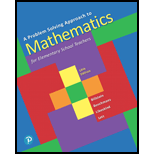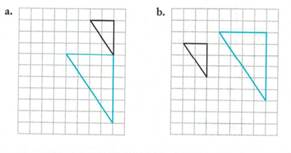
A Problem Solving Approach To Mathematics For Elementary School Teachers (13th Edition)
13th Edition
ISBN: 9780135183885
Author: Rick Billstein, Shlomo Libeskind, Johnny Lott, Barbara Boschmans
Publisher: PEARSON
expand_more
expand_more
format_list_bulleted
Textbook Question
Chapter 14.3A, Problem 1A
In the following figures, describe a sequence of isometries followed by a dilation so that the larger triangle is the final image of the smaller one.

Expert Solution & Answer
Want to see the full answer?
Check out a sample textbook solution
Students have asked these similar questions
CVE, AVM, AC, ¬SA¬ME
A Fitch Style proof for this argument
13:26
...
←
Robert F. Blitzer - Thinkin...
0,04
61
KB/d
目
polygons to create a fraudulent tessellation with discrepancies that
are too subtle for the eye to notice. In Exercises 45-46, you will use
mathematics, not your eyes, to observe the irregularities.
B
A
45. Find the sum of the angle measures at vertex A. Then
explain why the tessellation is a fake.
46. Find the sum of the angle measures at vertex B. Then explain
why the tessellation is a fake.
=et
at
If
se
Fic
SECTION 10.3 Polygons, Perimeter, and Tessellations 645
61. I find it helpful to think of a polygon's perimeter as the
length of its boundary.
62. If a polygon is not regular, I can determine the sum of the
measures of its angles, but not the measure of any one of its
angles.
63. I used floor tiles in the shape of regular pentagons to
completely cover my kitchen floor.
In Exercises 64-65, write an algebraic expression that represents
the perimeter of the figure shown.
is
be
64.
le
a
b
C
2/
If
se
ny
not use ai please don't
Chapter 14 Solutions
A Problem Solving Approach To Mathematics For Elementary School Teachers (13th Edition)
Ch. 14.1 - Prob. 1MCCh. 14.1 - Prob. 3MCCh. 14.1 - Prob. 5MCCh. 14.1 - Prob. 6MCCh. 14.1 - Prob. 7MCCh. 14.1 - A drawing of a cube, shown in the following...Ch. 14.1 - Wall stenciling has been used to obtain an effect...Ch. 14.1 - Prob. 10MCCh. 14.1 - The following figure is a partial tessellation of...Ch. 14.1 - Prob. 12MC
Ch. 14.1 - Prob. 13MCCh. 14.1 - Prob. 14MCCh. 14.1 - Prob. 15MCCh. 14.1 - Prob. 18MCCh. 14.1 - Prob. 19MCCh. 14.1 - Prob. 20MCCh. 14.1 - Prob. 21MCCh. 14.1 - Karrin claims that centers of rotation must be at...Ch. 14.1 - A student asks if the image seen through a...Ch. 14.1 - Jillian wants to know why a regular pentagon will...Ch. 14.1 - Prob. 26MCCh. 14.1 - Prob. 1NAEPCh. 14.1 - Prob. 2NAEPCh. 14.1 - Prob. 3NAEPCh. 14.1A - For each of the following, find the image of the...Ch. 14.1A - Prob. 2ACh. 14.1A - Find the coordinates of the image for each of the...Ch. 14.1A - Prob. 4ACh. 14.1A - Prob. 7ACh. 14.1A - Prob. 8ACh. 14.1A - Prob. 9ACh. 14.1A - Prob. 11ACh. 14.1A - Prob. 12ACh. 14.1A - Prob. 13ACh. 14.1A - Prob. 14ACh. 14.1A - Prob. 15ACh. 14.1A - A 1-inch blue square piece of sidewalk chalk is...Ch. 14.1A - Prob. 17ACh. 14.1A - Prob. 18ACh. 14.1A - Prob. 19ACh. 14.1A - Prob. 20ACh. 14.1A - Prob. 22ACh. 14.1A - Prob. 23ACh. 14.1A - Prob. 24ACh. 14.1A - Prob. 25ACh. 14.1A - Prob. 26ACh. 14.1A - Prob. 27ACh. 14.1A - Prob. 28ACh. 14.1B - Prob. 2ACh. 14.1B - Prob. 3ACh. 14.1B - Prob. 4ACh. 14.1B - Prob. 7ACh. 14.1B - Prob. 11ACh. 14.1B - Prob. 12ACh. 14.1B - Prob. 13ACh. 14.1B - Prob. 14ACh. 14.1B - Prob. 15ACh. 14.2 - Prob. 1MCCh. 14.2 - Prob. 2MCCh. 14.2 - Prob. 3MCCh. 14.2 - Prob. 4MCCh. 14.2 - Prob. 5MCCh. 14.2 - Prob. 6MCCh. 14.2 - Prob. 7MCCh. 14.2 - Prob. 8MCCh. 14.2 - Prob. 9MCCh. 14.2 - Prob. 13MCCh. 14.2 - Prob. 15MCCh. 14.2 - Prob. 17MCCh. 14.2 - Prob. 18MCCh. 14.2 - Prob. 19MCCh. 14.2 - Prob. 20MCCh. 14.2 - Prob. 22MCCh. 14.2 - Prob. 1NAEPCh. 14.2 - Prob. 2NAEPCh. 14.2 - Prob. 3NAEPCh. 14.2 - Prob. 4NAEPCh. 14.2 - Prob. 5NAEPCh. 14.2A - Assessment 14-2A Describe how to find the image of...Ch. 14.2A - Prob. 2ACh. 14.2A - Assessment 14-2A Determine the final result when...Ch. 14.2A - Prob. 4ACh. 14.2A - Assessment 14-2A a. Refer to the following figure...Ch. 14.2A - Prob. 6ACh. 14.2A - a. Reflect triangle ABC across line j, then across...Ch. 14.2A - Assessment 14-2A Given ABC and its reflection...Ch. 14.2A - Prob. 9ACh. 14.2A - Prob. 10ACh. 14.2A - Decide whether a reflection, a translation, a...Ch. 14.2A - a. Conjecture what the image of a point with...Ch. 14.2A - Prob. 16ACh. 14.2A - Prob. 17ACh. 14.2A - Prob. 18ACh. 14.2A - Point P is the image of P not shown under a glide...Ch. 14.2A - Consider the glide reflection determined by the...Ch. 14.2B - Prob. 1ACh. 14.2B - Prob. 2ACh. 14.2B - Determine the final result when ABCis reflection...Ch. 14.2B - Prob. 4ACh. 14.2B - Prob. 6ACh. 14.2B - Prob. 7ACh. 14.2B - Prob. 8ACh. 14.2B - Prob. 9ACh. 14.2B - Prob. 10ACh. 14.2B - Prob. 11ACh. 14.2B - Prob. 12ACh. 14.2B - Prob. 13ACh. 14.2B - Prob. 14ACh. 14.2B - Prob. 15ACh. 14.2B - In which line will the two intersecting circles...Ch. 14.2B - Prob. 18ACh. 14.2B - If PQ is the image PQ not shown under a glide...Ch. 14.2B - Prob. 20ACh. 14.2B - Prob. 21ACh. 14.3 - Prob. 1MCCh. 14.3 - Prob. 2MCCh. 14.3 - Prob. 3MCCh. 14.3 - Prob. 5MCCh. 14.3 - Prob. 6MCCh. 14.3 - Prob. 7MCCh. 14.3 - Prob. 8MCCh. 14.3 - Prob. 9MCCh. 14.3 - Prob. 10MCCh. 14.3 - Prob. 12MCCh. 14.3 - Prob. 13MCCh. 14.3 - Prob. 14MCCh. 14.3 - Prob. 15MCCh. 14.3 - Prob. 16MCCh. 14.3 - Prob. 17MCCh. 14.3A - In the following figures, describe a sequence of...Ch. 14.3A - Prob. 2ACh. 14.3A - In each of the following drawings, find...Ch. 14.3A - Prob. 4ACh. 14.3A - AB is the image of a candle AB produced by a box...Ch. 14.3A - Prob. 6ACh. 14.3A - Prob. 7ACh. 14.3A - Prob. 8ACh. 14.3A - Prob. 9ACh. 14.3A - Prob. 10ACh. 14.3A - Prob. 11ACh. 14.3A - Prob. 12ACh. 14.3A - Prob. 13ACh. 14.3B - Prob. 1ACh. 14.3B - Prob. 2ACh. 14.3B - Prob. 4ACh. 14.3B - Prob. 5ACh. 14.3B - Prob. 6ACh. 14.3B - Prob. 7ACh. 14.3B - Prob. 8ACh. 14.3B - Prob. 9ACh. 14.3B - Prob. 11ACh. 14.3B - Prob. 12ACh. 14.3B - Prob. 13ACh. 14.CR - Prob. 1CRCh. 14.CR - Prob. 2CRCh. 14.CR - Prob. 3CRCh. 14.CR - Prob. 4CRCh. 14.CR - Given that STAR in the figure shown is a...Ch. 14.CR - Prob. 6CRCh. 14.CR - Given that SNOSWO in the following figure,...Ch. 14.CR - Prob. 8CRCh. 14.CR - Prob. 9CRCh. 14.CR - Prob. 10CRCh. 14.CR - If a translation determined by (x,y)(x+3,y2) is...Ch. 14.CR - Prob. 12CRCh. 14.CR - Prob. 13CRCh. 14.CR - On a 1-m equilateral triangle pool table, a ball...Ch. 14.CR - Prob. 15CRCh. 14.CR - Prob. 16CRCh. 14.CR - Prob. 17CRCh. 14.CR - Prob. 18CRCh. 14.CR - Prob. 19CRCh. 14.CR - Prob. 21CRCh. 14.CR - Prob. 22CRCh. 14.CR - Prob. 23CRCh. 14.CR - Prob. 24CRCh. 14.CR - Prob. 25CRCh. 14.CR - Prob. 26CRCh. 14.CR - What dilation, if any, allows a line with equation...Ch. 14 - Prob. 1NT
Knowledge Booster
Learn more about
Need a deep-dive on the concept behind this application? Look no further. Learn more about this topic, subject and related others by exploring similar questions and additional content below.Similar questions
- pls helparrow_forwardUse the formulas developed in this section to find the area of the figure. A= (Simplify your answer.) 8.5 m 7 T 13 m 7.7 m m 21 marrow_forwardFind the circumference and area of the circle. Express answers in terms of and then round to the nearest tenth. Find the circumference in terms of C = (Type an exact answer in terms of л.) 9 cmarrow_forward
- Find the area of the figure. A = 4 m 11 m 13 m 5 marrow_forwardFind the exact values of sin(2u), cos(2u), and tan(2u) given 2 COS u where д < u < π. 2arrow_forward(1) Let R be a field of real numbers and X=R³, X is a vector space over R, let M={(a,b,c)/ a,b,cE R,a+b=3-c}, show that whether M is a hyperplane of X or not (not by definition). متکاری Xn-XKE 11Xn- Xmit (2) Show that every converge sequence in a normed space is Cauchy sequence but the converse need not to be true. EK 2x7 (3) Write the definition of continuous map between two normed spaces and write with prove the equivalent statement to definition. (4) Let be a subset of a normed space X over a field F, show that A is bounded set iff for any sequence in A and any sequence in F converge to zero the sequence converge to zero in F. އarrow_forward
arrow_back_ios
SEE MORE QUESTIONS
arrow_forward_ios
Recommended textbooks for you
 Holt Mcdougal Larson Pre-algebra: Student Edition...AlgebraISBN:9780547587776Author:HOLT MCDOUGALPublisher:HOLT MCDOUGAL
Holt Mcdougal Larson Pre-algebra: Student Edition...AlgebraISBN:9780547587776Author:HOLT MCDOUGALPublisher:HOLT MCDOUGAL Glencoe Algebra 1, Student Edition, 9780079039897...AlgebraISBN:9780079039897Author:CarterPublisher:McGraw Hill
Glencoe Algebra 1, Student Edition, 9780079039897...AlgebraISBN:9780079039897Author:CarterPublisher:McGraw Hill Elementary AlgebraAlgebraISBN:9780998625713Author:Lynn Marecek, MaryAnne Anthony-SmithPublisher:OpenStax - Rice University
Elementary AlgebraAlgebraISBN:9780998625713Author:Lynn Marecek, MaryAnne Anthony-SmithPublisher:OpenStax - Rice University Trigonometry (MindTap Course List)TrigonometryISBN:9781337278461Author:Ron LarsonPublisher:Cengage Learning
Trigonometry (MindTap Course List)TrigonometryISBN:9781337278461Author:Ron LarsonPublisher:Cengage Learning Elementary Geometry For College Students, 7eGeometryISBN:9781337614085Author:Alexander, Daniel C.; Koeberlein, Geralyn M.Publisher:Cengage,
Elementary Geometry For College Students, 7eGeometryISBN:9781337614085Author:Alexander, Daniel C.; Koeberlein, Geralyn M.Publisher:Cengage, Mathematics For Machine TechnologyAdvanced MathISBN:9781337798310Author:Peterson, John.Publisher:Cengage Learning,
Mathematics For Machine TechnologyAdvanced MathISBN:9781337798310Author:Peterson, John.Publisher:Cengage Learning,

Holt Mcdougal Larson Pre-algebra: Student Edition...
Algebra
ISBN:9780547587776
Author:HOLT MCDOUGAL
Publisher:HOLT MCDOUGAL

Glencoe Algebra 1, Student Edition, 9780079039897...
Algebra
ISBN:9780079039897
Author:Carter
Publisher:McGraw Hill

Elementary Algebra
Algebra
ISBN:9780998625713
Author:Lynn Marecek, MaryAnne Anthony-Smith
Publisher:OpenStax - Rice University

Trigonometry (MindTap Course List)
Trigonometry
ISBN:9781337278461
Author:Ron Larson
Publisher:Cengage Learning

Elementary Geometry For College Students, 7e
Geometry
ISBN:9781337614085
Author:Alexander, Daniel C.; Koeberlein, Geralyn M.
Publisher:Cengage,

Mathematics For Machine Technology
Advanced Math
ISBN:9781337798310
Author:Peterson, John.
Publisher:Cengage Learning,
Quadrilaterals: Missing Angles and Sides; Author: rhornfeck;https://www.youtube.com/watch?v=knVj1O0L2TM;License: Standard YouTube License, CC-BY
STD IX | State Board | Types of Quadrilateral; Author: Robomate;https://www.youtube.com/watch?v=wh0KQ4UB0EU;License: Standard YouTube License, CC-BY